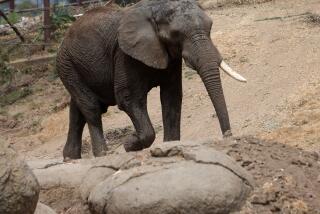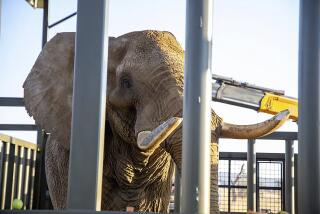Sri Lanka to Try to Domesticate 500 Wild Elephants
- Share via
BOGASWAWA, Sri Lanka — A sedated elephant trumpeted and lurched in the dense jungle of north-central Sri Lanka, straining against the chains anchoring its feet to thick trees.
About 1 1/2 miles away, wildlife workers yelled encouragement as another stunned elephant, trunk flailing and huge ears flapping, got to its feet with the aid of a crane.
The two animals were the first tranquilized and captured in a government effort to domesticate 500 wild elephants.
Progress will be slow and could take 10 to 15 years, said Nandana Attapattu, 36, a veterinary surgeon in charge of the project run by the Department of Wildlife Conservation.
“In some cases, we will have to capture herds so that we do not break up the grouping,” Attapattu said, seated in a canvas tent at the edge of the jungle.
Most of the animals to be captured are described as “rogue elephants,” those that have killed people and destroyed homes or crops.
Attapattu said about 50 people are killed every year by elephants that stray into villages as their jungle habitat shrinks. Deforestation has reduced Sri Lanka’s forest cover from 50% in 1948 to less than 20%.
An average of 40 elephants are killed annually, but there is no organized poaching because of the belief among the predominantly Buddhist population that killing elephants brings bad luck, Attapattu said.
Government officials say 75 elephants were killed last year. They blame at least 33 of the killings on ethnic Tamil rebels who have set up bases in the jungles during a 7-year-old separatist war against the majority Sinhalese, who control the government and army.
The elephant lifted by the crane was so badly wounded by bullets from automatic rifles that Attapattu said he feared for its life.
He said the animal--nicknamed Loku Aliya, which means big elephant in Sinhalese--would have died in a few weeks if left in the wild.
Forest rangers tracked the other animal, which also had been shot with automatic weapons, for 4 miles before tranquilizing it with a rifle dart, the veterinarian said.
Attapattu said the 10-foot-tall elephant was 38 years old and nicknamed Niyapottaha, the Sinhalese word for nail, because of a foot deformity. It is the largest ever captured in Sri Lanka, he said.
“This project is mainly to save the elephant population,” Attapattu said, but “we also will be saving human lives and property.”
Elephants were killed for sport in the 1800s, when Sri Lanka had 20,000. Restrictions were gradually imposed, and killing elephants was outlawed in 1938. An estimated 2,500 remain in the wild.
A five-member Malaysian wildlife team is helping local authorities with the project. The wildlife department plans to capture 15 elephants in Maduru Oya district during the initial phase, which will cost $3,250 and is largely financed by the U.S. Agency for International Development.
Part of the project’s cost will be covered by selling the captured elephants after they are trained, which Attapattu said could take between six months and a year.
A domesticated elephant is expected to fetch about $8,750, and exceptional ones with handsome tusks could bring more than four times that, Attapattu said.
Rich landowners keep elephants as status symbols, timber merchants use the animals to fell and drag trees, and some Buddhist temples use them in ceremonies.
More to Read
Sign up for Essential California
The most important California stories and recommendations in your inbox every morning.
You may occasionally receive promotional content from the Los Angeles Times.









